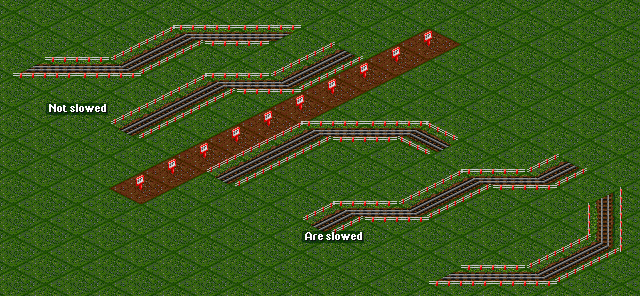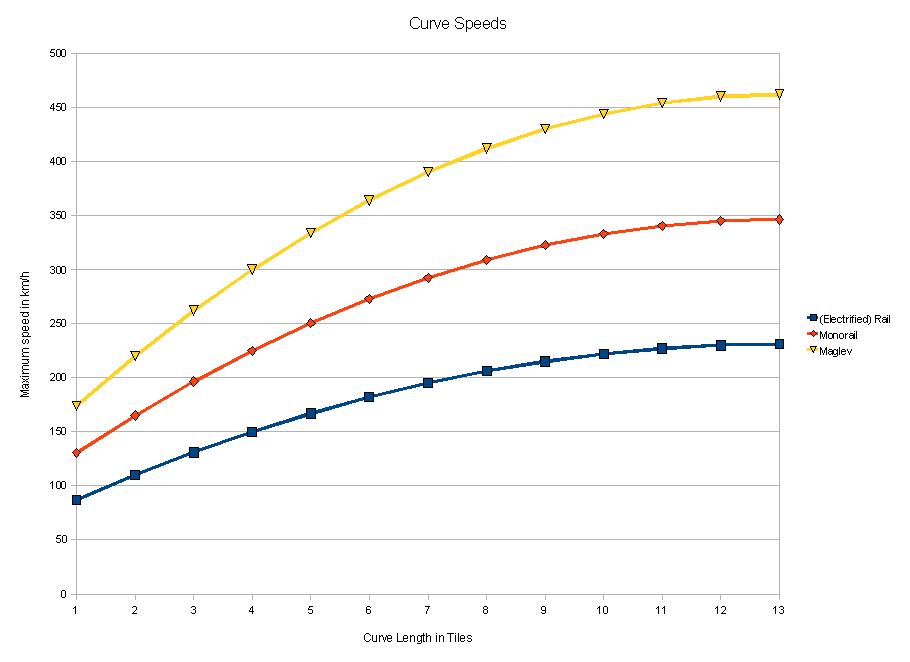Difference between revisions of "Max Curve Speed"
From #openttdcoop wiki
m (Add see alsos) |
(extended. Source: http://hg.openttd.org/openttd/trunk.hg/file/915aed927f42/src/train_cmd.cpp#l298) |
||
| Line 1: | Line 1: | ||
The speed a normal rail curve allows can be calculated using the following formula: | The speed a normal rail curve allows can be calculated using the following formula: | ||
| − | Maximum speed in km/h = 231 - (13-CL)^2 | + | Maximum speed in km/h = 231 - (13-CL)^2<br> |
| + | CL in the formula is limited to a maximum of 13. | ||
| − | + | For two curves in the same direction, CL is the number of half-tiles between the 45°-turns. If three or more curves are within the length of a train, the game calculates an average curve length based on the part of the train which is between those curves and the total number of total curves - 1. | |
| + | This can lead to strange effects: A third bend can increase the average curve length and allow a higher speed of the train. | ||
| − | + | Two 45°-turns with a single diagonal half-tile in between will always limit the speed to 88km/h, independent of other curves. | |
[[Image:slow_corners.png|frame|none|An example showing which corners are affected]] | [[Image:slow_corners.png|frame|none|An example showing which corners are affected]] | ||
| + | |||
| + | |||
| + | Monorail and maglev use the same formula but get a 50% and 100% speed bonus respectively, resulting curve speeds are shown in the graph below. Tilt increases the maximal speed by 20%. | ||
| + | |||
| + | [[Image:curve_speeds1.png]] | ||
| + | |||
| + | |||
== See Also == | == See Also == | ||
* For some more detailed information see {{User|Mark}}'s blog post: http://www.openttdcoop.org/blog/2009/05/13/about-curve-lengths/ | * For some more detailed information see {{User|Mark}}'s blog post: http://www.openttdcoop.org/blog/2009/05/13/about-curve-lengths/ | ||
* [[User:KenjiE20/Webster#Curve Length Calculator|Webster's helper function]] | * [[User:KenjiE20/Webster#Curve Length Calculator|Webster's helper function]] | ||
Revision as of 19:39, 15 December 2012
The speed a normal rail curve allows can be calculated using the following formula:
Maximum speed in km/h = 231 - (13-CL)^2
CL in the formula is limited to a maximum of 13.
For two curves in the same direction, CL is the number of half-tiles between the 45°-turns. If three or more curves are within the length of a train, the game calculates an average curve length based on the part of the train which is between those curves and the total number of total curves - 1. This can lead to strange effects: A third bend can increase the average curve length and allow a higher speed of the train.
Two 45°-turns with a single diagonal half-tile in between will always limit the speed to 88km/h, independent of other curves.
Monorail and maglev use the same formula but get a 50% and 100% speed bonus respectively, resulting curve speeds are shown in the graph below. Tilt increases the maximal speed by 20%.
See Also
- For some more detailed information see Mark's blog post: http://www.openttdcoop.org/blog/2009/05/13/about-curve-lengths/
- Webster's helper function

